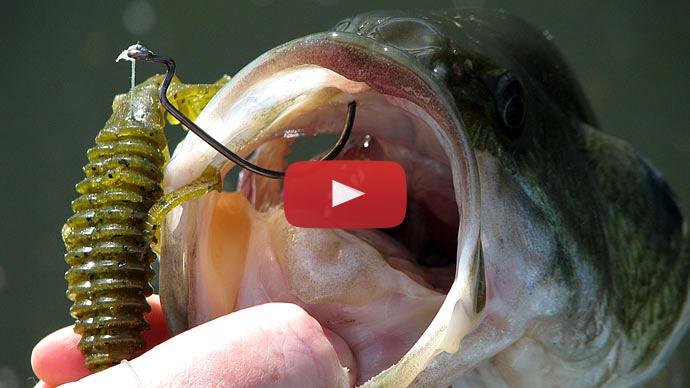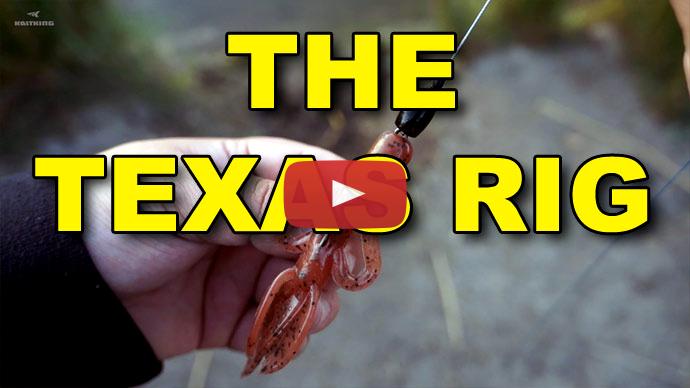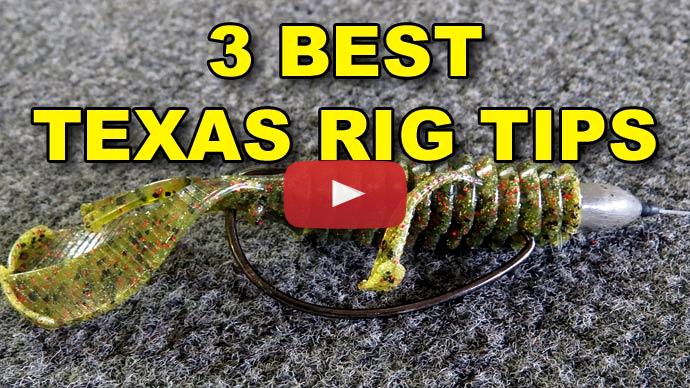Hey, folks, Glenn May here with BassResource.com. And today, I want to talk to you about choosing line for Texas rigs. Now, there's a whole variety of applications you can use Texas rigs for. So, for me, it breaks down to basically four different types and that is: finesse fishing, your regular Texas rig fishing which most people are associated with throwing out in kind of sparse cover and docks and just Texas rigging different plastics to avoid them from getting hung up, there's the flipping and pitching setup for heavy cover, and there's the punching setup, which is heavy-duty stuff.
So, let me go through the different lines that I chose for those different setups starting with finesse. So, for this finesse setup, you know, Texas rigs for baits such as like this, kudos for anybody who knows what that bait is, but that's nice in Texas rig. What that does is, for real finesse type, this is split-shot rig that I'm using. That's the weight I used on it. This is for the real slow bite, real soft and subtle. The fish have a lot of time to examine this bait and to look at it and, of course, to examine your line too. And typically, I'm fishing this in clear water. It's open, there's not a whole lot of cover involved, you're not gonna get snagged up in a lot of stuff, maybe it's a little rocky.
So, for those type of situations, I'm using the light line. This is a light wire hook. It's only a 1/0 hook, thin wire, so you can overpower it if you're using braid. These thin wire hooks aren't gonna... Well, let's put it this way. You need your system to match. If it's a thin wire hook and you've got a lot of strong lines, strong rod, you've got drag set down, then that weakest link is your hook and you're gonna bend it. And this is true for all these different set ups I'm gonna tell you. It's really dependent upon that hook that you're using. You wanna make sure that you don't bend that hook out.
So, in this case, since it's a real thin wire hook, light situation, I'm looking at 6 pound, maybe up to 10 pound, but 6-pound line is what I'd like to use, either fluorocarbon, I like Seaguar Finesse fluorocarbon line, or I'll use copolymer line. And the real difference is, if I'm using fluorocarbon, if I'm really looking for that real subtle bite, I'm trying to keep the bait up off the bottom, say for example, in a drop shot situation, that sort of thing. I'm using fluorocarbon for that real sensitive bite. If the fish are hitting it right on the fall, right away, then I don't need that sensitive of a line so I may use copolymer in that instance.
But, that's typically what I'm using, 6 to 8-pound fluorocarbon or copolymer line. You can use mono as well, if you want. Mono's got nice stretch qualities to it, which works when you're fighting a fish back in this situation. So that's finesse.
So, the other one, and the next one, is Texas rig, your standard Texas rig. Which what I mean by standard? As you're looking at your 7-foot, medium heavy power rod with a fast action tip. This is your, you know, typical Swiss army knife of bass fishing. If you don't have a medium-heavy, 7-foot rod, you need to get one because you can throw all kinds of baits with it. And in this case, we're talking Texas rig.
So, with this, you can throw it in a variety of situations and what I prefer to do here is throw this in sparse cover, you know, scattered cover, scattered weeds, lily pads, patches of milfoil, patches of hydrilla, throw it around docks, logs, scattered bushes that are flooded, variety of things. It's somewhat open but, you know, the fish are hiding in the cover and I'm gonna be throwing to that.
So, for that, I'd like to use 30-pound braid, typically. Sometimes, I'd like to use Seaguar braid, that's one of my preferred ones. And this one, what I'm doing here today, is I've been fishing this Berkley Creature Hawg, this is the MaxScent Creature Hawg, which I really like. And I've been throwing it in open water, like you see behind me. I've been fan casting it. So, I want greater distance. So, in that case, I'm using FireLine Ultra 8, FireLine 30-pound test because it casts really far. And I'm just, you know, throwing it to 1:00 to 2:00, 3:00, I'm just fan casting, covering water. These fish are out on flats, out in scattered bushes, out in deeper water. So just covering it that way is a great way to throw it.
This Berkley FireLine works really well if you throw them around docks. I'm throwing around open weeds, that sort of thing. If I'm throwing around a whole lot of rocks, if it's just or mostly rocks, then I kinda shy away from the braided lines. I tend to use more fluorocarbon in that instance. Braid tends to get scuffed up more, believe it or not, in rocks. As abrasion resistant as they are, they tend to get all scuffed up in rocks. So, I like to use fluorocarbon or copolymer, or maybe even mono line in those situations. About 30-pound test is about all I need in those situations.
So, moving on up, now we're gonna go in the flipping and pitching set up. And for those... I'll get that in there. For those, I like to get a little bit more heavy duty. In that case, I'm using a heavy power rod with a fast tip. I'm using it here, 7'4" to 7'6" rod. But for the line, now I'm using Seaguar Smackdown Braid, it's a 50-pound test, that's what I'll go for. And for these situations, now I'm throwing it in flooded brush, flooded timber. I'm throwing it in heavy cover where the fish, you gotta dig 'em out, dig 'em out of those thicker weeds, that sort of thing.
You've got to have the power of the rod, you've got to have the power of the braid, and of course, now with the hook, instead of using that 1/0 thin wire hook like I was using in finesse and with the previous setup, I might be using a 2/0 to 3/0 standard sized hook. Here I'm using a 3/0 Superline hook is what they call them or a flipping hook. It's a thick wire hook. Again, you want that hook to stand up for the power that you're throwing. So, you need to have a hook that can stand up to it. This rod doesn't flex much. You can see it just flexes right towards the end, and that's it. It's a pretty stiff rod because you're gonna be throwing on this heavy stuff.
So that's what I use for standard flipping and pitching, 50-pound braid. It works great for these situations.
Now, the fourth kind, which I don't have hooked up today because I'm not throwing in it. But that's for fishing punching. Now, punching is a little bit different. Punching your fishing in those big vast mats of weed. It's either hydrilla or milfoil that's topped over, and it's just a big mat. You got to get that lowered down through that thick mat of weeds and there's big fish underneath it. You've got to haul them out typically with several pounds of weeds wrapped around them. It's a heavy load. You need some stiff hard equipment for that.
So, with that, I'm using a heavy, heavy action or heavy, heavy power rod, usually a 7'11", something that stout. I'm using again a 3/0 to 4/0 stout flipping hook. And for that, for the braid, no less than 65-pound braid is what I'm using. The Seaguar Smackdown works really well for that. A lot of guys like to go for 80, 85-pound braid. I think that's a little stiff for me, but that's all right. You know, it's your personal preference, what you feel most comfortable with. The idea here is you're putting about a 3/4 to an 1 1/2oz bullet weight in the front, and you're throwing a bait that's just like this. It's streamlined. So, it will go through those weeds and it's kind of a bullet shape, if you can see that, which is perfect for going through those weeds and the fish are underneath it. You hook on to them that 65-pound braid. That's what you're gonna need to haul those fish out.
So, those are the different setups I use, those are the different kind of lines I use. There's no absolute in fishing. There's no right or wrong. So, if you don't fish it that way, you have a different way of doing it, and it works great for you, do it. It's all about confidence. But those are what I use.
If you're trying to figure out, like, you start now and you're not sure which way to go, that's the way I do it. Watch some other YouTube videos if you want to get an idea of what you wanna start with. But that kinda gives you a starting point to figure out the different types of lines to use for the different kinds of cover and set up that you're fishing. Hope that helps. For more tips and tricks like these, visit BassResource.com.



